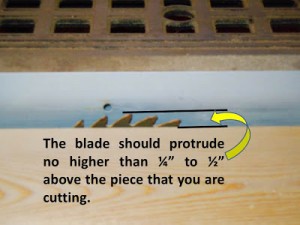One of the most used and most versatile power tools is the table saw. It is also one of the most dangerous. Each year more than 40,000 table saw accidents occur. Many of these accidents result in the loss of a limb. To prevent becoming a statistic, follow these rules:
- Owner’s manual. Thoroughly read (and understand) the owner’s manual. Always work within the capabilities of the machine and follow the manufacturer’s instructions.
- Safety Equipment. While operating a table saw, always wear safety glasses, hearing protection and a dust mask.
- Work Clothes. Never wear long sleeve shirts, loose clothing or gloves. Tie back long hair and remove chains/necklaces. Always wear slip resistant footwear.
- Practice good housekeeping in your shop. To prevent slips and falls, keep your floors free of debris. In addition, a table saw is a table saw, not a storage shelf for the other tools you may be using.
- Allow three feet of clearance around your table saw, so that your movement is unimpeded during its operation.
- While you are making adjustments to your table saw or changing the blade, always disconnect the power. Merely switching the saw “off” is not sufficient.
- Always use a sharp blade. Sharpen or change the blade whenever cutting becomes labored.
- Always choose the blade type designed for the work you will be performing.
- Do not remove safety guards.
- Adjust the height of the blade so that it protrudes no higher than ¼” to ½” above the piece that you are cutting.
- When you are not using your table saw, lower the blade below the surface of the table or place a protective cover over the exposed blade. .
- Make sure that the fence guide is parallel to the blade. This will prevent the piece that you are cutting from binding, which can result in kick back. As you are cutting, keep the piece tight up against the fence.
- Never stand directly behind the blade. Standing to either side of the blade will keep you out of the line of fire in the event of kick back.
- Never reach over the blade, while it is turning or attempt to remove your piece until the blade comes to a complete stop. .
- While operating your table saw, your hands should never come closer to the blade than six inches.
- When cutting smaller pieces, always use a push stick.
- When cutting larger pieces, always use an out-feed table. This will prevent loss of control, as you are cutting sheets of plywood or ripping long pieces of lumber. Remember, work within the equipment’s limitations. If a larger piece is to unwieldy to cut on your table saw, use a circular saw, which will give you a greater degree of control.



